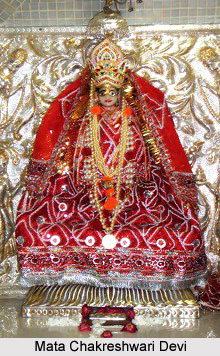 Mata Chakreshwari Devi Teerth located in Punjab is a Jain pilgrimage centre. The teerth kshetra is situated in the village of Attewali in Sirhind town on Sirhind Chandigarh Road. The temple is dedicated to Bhagwan Rishabh Dev, the first Jain Tirthankara and Mata Chakreswari Devi.
Mata Chakreshwari Devi Teerth located in Punjab is a Jain pilgrimage centre. The teerth kshetra is situated in the village of Attewali in Sirhind town on Sirhind Chandigarh Road. The temple is dedicated to Bhagwan Rishabh Dev, the first Jain Tirthankara and Mata Chakreswari Devi.
History of Mata Chakreshwari Devi Teerth
The history of Mata Chakreshwari Devi Teerth dates back to the ancient times. This ancient temple is believed to be around 1000 years old. The teerth is associated with many miracles and legends. According to a legend during the rule of PrithviRaj Chauhan, a large group of devotees were going on a pilgrimage tour from Rajasthan in bullock carts to the ancient Jain Temple of Kangra in Himachal Pradesh. They were going to offer their prayers and seek the blessings of Bhagwan Rishabh Dev. While going for the tour the pilgrims also carried the idol of Mata Chakreshwari Devi. She was a devoted worshipper of Bhagwan Rishabh Dev. Mata Chakreshwari Devi is also known as Adishthayak Devi or Shasan Devi. On their way the pilgrims rested at Sirhind at night. The next morning when the pilgrims were all set to begin their journey, the bullock cart that was having the idol of Mata Shri Chakreshwari Devi did not move. Inspire of all efforts the cart refused to proceed. The devotees could not understand the reason behind it and became much tensed. Suddenly they saw a flood of light inside the caravan and there was an aakashvani stating that this she must be installed in this particular area. Hearing this, the pilgrims said that as the place was sandy there was no availability of water. Even they too faced many problems. The mother then instructed them to dig the land a few yards towards the north of this place. This would fetch them water. The pilgrims did as instructed and were surprised to see the flow of water. Seeing this miracle the pilgrims were very pleased and hence they installed the idol of Mata Chakreshwari Devi. They also constructed a beautiful temple and settled down here. The place where a fountain of water had erupted has been developed into a small well known as amritkund. The holy water is considered to be very holy by the devotees even today. Pilgrims also carry this sacred water and preserve it in their homes.
The idol of Bhagwan Rishabh Dev is believed to possess miraculous powers and is visited by thousands of Jains and non Jains from far off places. They come here to offer their prayers to the Lord and receive his blessings. It is believed that if prayed with all devotion the Lord fulfils the wishes of the pilgrims.
Temple of Mata Chakreshwari Devi Teerth
The temple of Mata Chakreshwari Devi Teerth houses the idols of Bhagwan Rishabh Dev and Mata Chakreshwari Devi. The Swetambara temple has been brilliantly decorated with intricate artistic designs that enhance the look of the temple. The creative works of the craftsmen depicts their skills. The walls and pillars of the temple are adorned with specimens of ancient art and paintings. The spiritual powers of Mata Chakreshwari Devi have been depicted beautifully on one of the walls of the temple through very fine glass work. The idol of Bhagwan Rishabh Dev is 51 cms in height and is white in colour. It is seated in a padmasana posture. The idol of Mata Chakreshwari Devi is also 51 cm in height and is white in colour. The idols have been beautifully carved from a single stone and look very appealing. The divine face of the Lord looks very calm and serene.
The Temple of Mata Chakreshwari Devi Teerth organizes many annual gatherings and functions that are celebrated with much enthusiasm. Every year a fair is held here in the month of Kartika. There are provisions for dharamshalas or rest houses for the pilgrims. These are well equipped with all modern facilities. Apart from this there are Upashrays, an Ayambilshala and a Jnanabhandar. The teerth is situated in the midst of beautiful natural surroundings. Being located in a village the temple is enclosed by scenic beauty and greenery that mesmerizes and fascinates the pilgrims. The calm and tranquil environment makes the teerth a suitable place for religious activities. The kshetra is well connected to road, rail and air. Taxi services and bus services are easily available here. The nearest bus stand is located at Sirhind approximately half-way between Ambala. The nearest railway station is located at Fatehgarh Sahib and Sirhind. The nearest airport is situated at Chandigarh.









